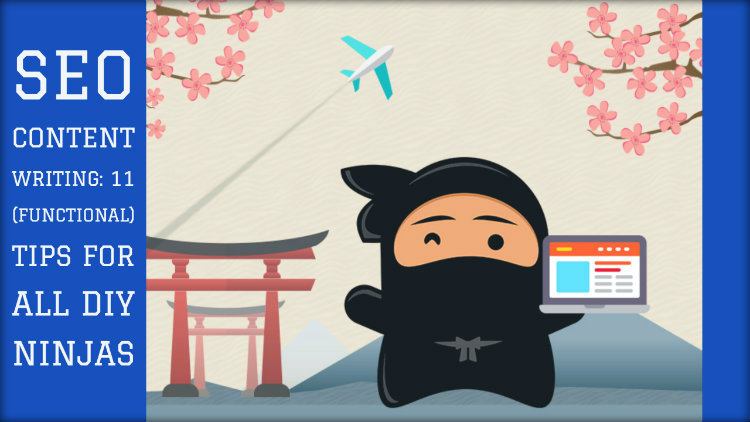Publish high quality contents and include keywords in the copy.
This single sentence easily sums up the majority of guides, tips, and tricks on SEO content writing that the world has read in the past decade.
And honestly, we’re all bored.
Yes, one, you must create high-quality content. And second, the content must be optimized with keywords.
But these two SEO writing tips have aplenty of flaws.
They are old. They are boring. They are vague. And a website content writer who’s genuinely looking for few tips, she/he gets nothing out of them.
So, what do we do?
Simple. Scrap all the cliched “tips” and replace them with the new ones that are in sync with the redefined definition of Search Engine Optimization.
If you’re a do-it-yourself ninja, here are 11 functional SEO content writing tips that will turn your copies into the traffic magnet:
1.Stop obsessing the keywords
A lot of blog posts that date back to a few years, they have keywords spilled everywhere. And since the content is short in itself, the high keywords density makes the copy virtually senseless.
If you’re still stuck in those days, this might come as a shock: Today, search engines do not care about keywords as much as they once did.
To find content relevancy, they have many other parameters.
So, as an SEO content writer of this new age, you need to stop obsessing the keywords.
Don’t worry about plugging these phrases in lines and paragraphs that totally mess what you’re trying to mean and make you grammatically incorrect.
2.The thing about keywords...
Now, the thing about keyword is, less important as it may, it’s important nonetheless. So, you’ve got to use your primary and secondary keywords in the article.
Just do it a couple of times and nothing much.
It is the LSI keywords should you focus more on.
Generally put, Latent Semantic Indexing keywords are synonyms or related words. These days, to gain more information about the content’s intent, search bots are looking for these LSI phrases.
For instance, if you have written an article on “Orange”, how will the search engine identify that you’re really talking about the fruit and not the color?
It will look for the word's (orange) related phrases to understand the content's intent, like 'fruit' 'apple' and 'vitamin'.
So, to ensure Google and Bing know more about your content, after a couple of main keywords’ usage, rely entirely on LSI phrases.
LSI Graph is possibly the best LSI keyword generator out there.
Also Read: 5 Steps to Change Your SEO Strategy For Semantic Searches
3.Format the article correctly
People find it hard to concentrate on and read a cluster of words and sentences that have no breaks.
Psychologically, they require the breaks to consume whatever they have read and then prepare to understand the next piece of information.
In the context of web contents, change of paragraphs is that "break".
Your paragraphs must be small. Sometimes including just one line. But never more than 3-4 sentences.
(Like we have done in this post!)
Also, talking about formatting your content, you must be selective in using the bold, italics and underlining options.
The headings must be formatted correctly.
The main title of the blog post must have <h1> tag. The sub-heads in the articles should be covered in <h3> tag; the sub-sub-heads be <h4>; follow this sequence, if needed, till <h6>.
Simple formatting steps like these can easily help you woo the search engines, as well as enhance the UX.
4.Publish long-form contents
It is believed that long-form contents are usually more resourceful. And they solve problems from the core.
While this is not entirely true, we do find long contents to be much better vs. the short ones. For this reason, search engines love comprehensive articles.
According to a study, the average Google first page result contains 1,890 words. There have been many similar studies done by various agencies, concluding in favor of long contents.
So, again, while it is not mandatory, it’s usually a good practice to keep your articles long so the search engines find them resourceful.
Besides, if you’re really looking to produce high-quality, helpful article, its word limit would usually cross the 1500 mark without you forcing it.
5.Solve at least one problem in the post
When you read a very good article from a reliable resource, by the end, you usually have what you’re looking for. Don’t you?
That’s the key feature of high-quality contents-they focus on users’ problems and intents. And they deliver them what exactly are they looking for.
Sounds vague?
When writing, just note to solve at least one problem of the target audience with this piece of content.
If you do that, you can rest assured that your piece is of high-quality.
And when users find your article helpful, it will cascade to turn a lot of your metrics green (bounce rate, dwell time and more), which will go on to improve your website’s ranking.
6.Talk like a human and NOT robot
Gone are the days when formal writing reined online. Today, courtesy of high social adaptability, it’s all about engagement.
Meaning to say, your content must be engaging. You must write like you’re talking to a human, like a human. Like this piece of article.
The article must be interactive, emotion-laced, and be in a conversing, informal tone.
People don’t want to read an article like they are reading a newspaper.
They would find you obnoxious and NOT intelligent if you continuously toss in sophisticated and difficult words.
Readers, online, want to understand and NOT know how good of a writer you are.
So, write and talk to them like a person, like a friend.
7.Link to other internal (and outbound) links
This is SEO 101. In the article, include links to other posts and webpages whenever the room allows.
Also, you must not hesitate in linking to third-party websites, fearing the wastage of link juice.
When you link to other relevant, authority websites, it sends positive signals to the search engines. It helps them understand your content better.
So, wherever comes the need, plug in outbound links.
And oh, don’t obsess the anchor texts; they don’t necessarily have to be your keywords if you find doing this forceful.
8.Plug in relevant images and videos
If you have a media team or if you’re working in any digital marketing agency in Kolkata, the other team will do this for you.
If not, it’s not that difficult either.
If it fits the article, to enhance its usability, you can embed YouTube videos in it. This will not only make your piece more interesting and resourceful BUT will also increase your dwell time, which will boost your SEO.
In a similar way, use good-quality, optimized images (and infographics) wherever necessary. There are countless websites from where you can download good pictures for free. Pixabay is one of our favorites.
Make sure, whatever media you’re including, it is actually enhancing or supplementing what you’re saying in the text.
Don’t use images and videos just to fill the space.
9.Do you know some facts and figures?
The easiest way to add credibility to your article, and hook the readers, is to include facts and figures in it.
Of course, this might not be possible for a range of niches. If you’re writing on something unique, you might not find any wow-worthy statistics on that topic.
But, in case, if you do find the correct numbers, plug them properly to stress over what you’re trying to explain.
[Here’s us, following what we preach: Did you know that small businesses with blogs get 126 percent lead growth than small businesses without it? *mind boggled*]
10.What’s the call to action?
Every piece of content should have a well-defined purpose that leads to the bigger picture.
This “bigger picture” could be anything-get more followers on social media, generate leads, convert a prospect into a purchasing customer and so forth.
What exactly do you want to achieve with your article? Why are you writing it in the first place?
Your content must help you achieve your business goals, as well as help your readers off their problems.
So, your article must usually end with certain Call to Actions (CTAs). Like, if you’re trying to sell something, ask people to purchase it.
If you want the readers to implement what they have just read, outline them a plan for that.
11.Revise, revamp and repurpose
Your article is not perfect. Period.
And it’s likely that you’re going to cringe on it yourself a year later.
So, making improvements in what you have written is an on-going process. Be it to fix its grammar and tone or make some core updates.
This is also important if your business goal has changed. For instance, at the time of writing, you were more focused on generating leads.
Over time, now, maybe you want readers to purchase your eBook.
So, to keep up with your changing business goals, as well as to be in sync with the latest market trends, you must, on a regular basis, do content auditing.
Revise what you have written. And if needed, revamp and repurpose the articles.
Conclusion
These are 11 functional SEO content writing tips for all the DIY ninjas.
Admittedly, when putting it with the marketing angle, writing web content isn’t very easy—even if you’re a good writer.
From search optimization to user experience to (the biggest headache) distribution, you have to take care of so many things.
And things get even messier if you start seeing content writing in the context of content marketing, which automatically expands its scope.
Also Read: The Changing Game of SEO
This is why, if you’re looking to achieve real business goals, having a good digital marketing agency by your side is always a good idea.
Here, at Kreative Machinez, we offer high-quality SEO writing services. Whether you’re looking for a professional website content writer to write you high-converting copies or want an SEO expert to audit your website (and existing contents)-we’ve got you covered from every angle. Contact us today and let’s talk.
Direction:- https://goo.gl/maps/iQNGWa4K2Rr




